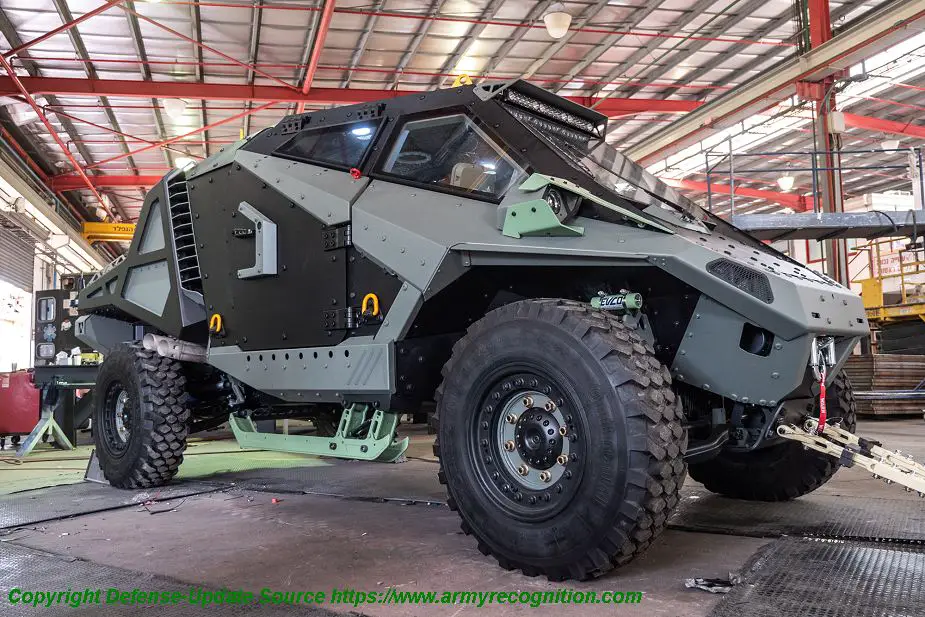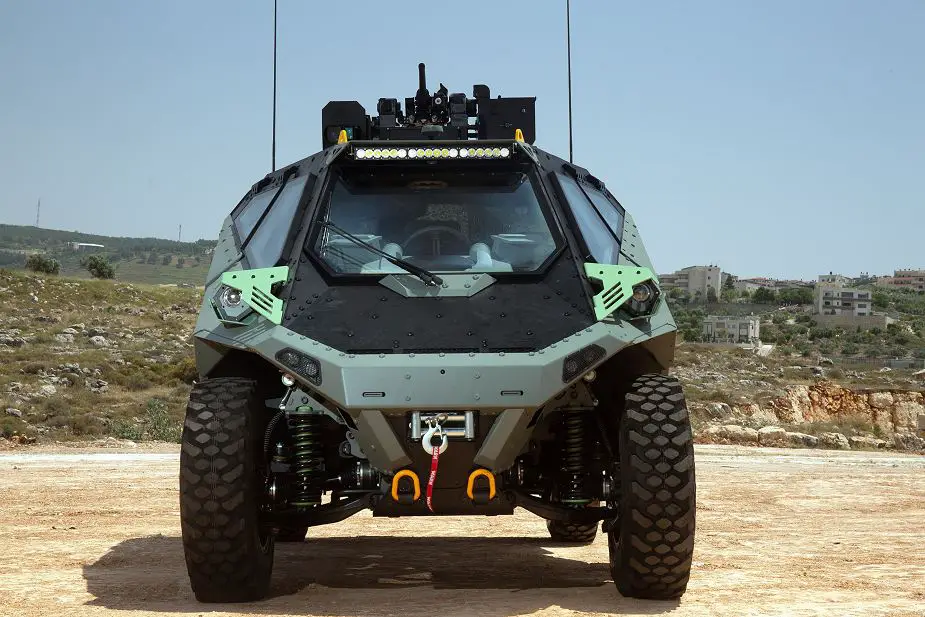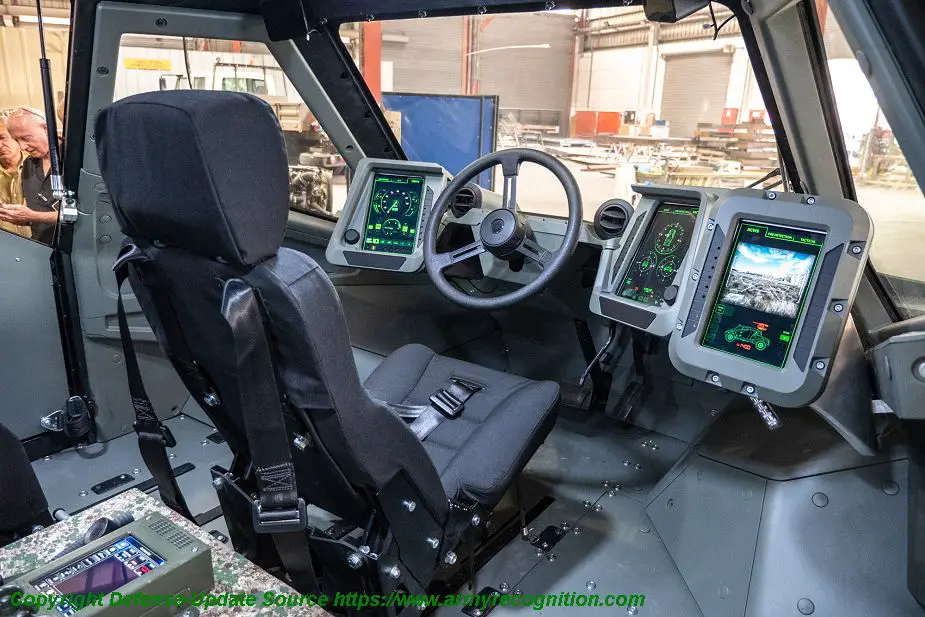Israel’s specialty and combat vehicle producer Carmor unveils the Mantis at Eurosatory2018.The vehicle to be displayed at the defense exhibition in Paris next week is the first variant of a new family of vehiclesdesigned to perform combat and combat support missions. (Source Defense Update Tamir Eshel)

The Carmor Mantis 4x4 light protected vehicle include a versatile double cabin troop carrierthat carries five soldiers, and a full cabin version that accommodates eight. (Picture source Defense Update)
To meet higher levels of protection required by the users the company optimized the design to provide both ballistic and blast protection while maintaining high agilityand retain adequate payload capacity at a gross vehicle weight below eight tons.The vehicle’s size and weight enable tactical air mobility in C-130 Hercules and A-400M transport aircraft.With such characteristics Carmor positions the Mantis to offer JLTV class performance at an affordable cost.
“Unlike the heavier vehicle models developed by Carmor and its predecessor ‘Hatehof’, the Mantis,based on a clean sheet design is lighter, more agile and modular.” Eitan Zait, Carmor CEO explained, “We have designed, developed and built thousands of vehicles, in dozens of configurations, all were designed to meet specific requirements set by the customer.” Zait explained, “Mantis comes from a clean sheet design, that reflects the best Carmor’s designers could offer.”
The family consists of a common monocoque capsule that provides the chassis and protected cab for the different variants. The chassis eliminates the need for a traditional frame and enables the flexibility to extend the vehicle by up to 150 cm, to meet specific configurations.
All variants use common subsystems and parts. The powerpack consists of a 6.8 litre 360 horsepower Cummins turbo-diesel coupled to a 6-gear Allison automatic transmission is centrally located, adding to the vehicle’s stability. The cooling system is also located at the rear, fed by airducts on both sides and on the roof. The engine accelerates the eight-ton Mantis to a maximum road speed of 120 km/h. Using automotive systems and parts certified for commercial and racing, the 4x4 wheel is designed for off-road mobility and versatility.
The vehicles includea versatile double cabin troop carrierthat carries five soldiers, and a full cabin version that accommodates eight. Some of the designs incorporatean elevatedplatformthat mounts payloads up to 150 kg weight, such as remotely controlled weapon stations shown on the prototype displayed at the Eurosatory. A single cabin pickup variant that seats three soldiers has a larger flatbed while a variant of the full cab is configured as an ambulance, accommodating a small crew and ample space for stretchers and medics. Carmor also considers an openbuggy style fast and light assault vehicle variant that will utilize the same structure and offer underbelly protection.
These variants can support a wide variety of applications carrying different weapons such as mortars, missiles, machine guns and remote weapon stations, along with scout and reconnaissance equipment, including payloads telescopic masts, ground and aerial robotics, tactical radars and counter-UAV equipment

Front view of the new Carmor Mantis wheeled light protected vehicle (Picture source Israel Defense)
Carmor designers achieved high level of protection at relatively low height, by using an advanced belly design that maintains low center of gravity with excellent blast protection, results in an overall vehicle height below 2.20 meters. Superior off-road mobility is achieved by a short wheel base, ground clearance of 0.65 meters, and approach and departure angles exceeding 50 degrees, all critical factors for good off-road mobility. The powerful engine and transmissions sustain movement over 70% gradient, 40% side slope, up to 0.5-meter obstacle climb and trench crossing and fording through water one meter deep.
According to the vehicle designer Amos Boaz, Mantis maintains an optimal balance of agility, protection and comfort. Placing the engine at the center, between the cab and the flatbed, clearedsix cubic meters of protected cabin, comfortably seating five soldiers in individual seats. These blastsprotected seats,made by Mobius-PS,are specially designed to attenuate the blast effects of underbelly explosions, as they act with the ‘floating floor’ and specially designed belly shape to minimize the effect of IED and mine blasts.
Despite its low signature and relatively light weight, Mantis offers high baseline protection meeting ballistic, IED and mine protection. At a gross vehicle weight of six tons Mantis provides ballistic protection at a STANAG 4569 Level 3, with minimal mine protection (Level 1);adding modular armor replacement plates, Mantis can face much heavier threats with ballistic protection upgraded to Level 4, and blast protection to Level 2A/3B. Using relatively small transparent armor modules the cabin provides excellent viewing to the front and sides, Boaz told Defense-Update.
The Mantis protection is not addressing only ballistics and blast but also the vehicle’s mobility. Using Runflat inserts, Mantis maintains mobility even after suffering multiple hits in the tires; 105 litres of fuel are stored in dual,independent fuel tanks to support mission autonomy of 700 km with internal fuel.

The centrally located driver ‘cockpit’ is unique design feature of the Mantis family. (Picture source Defense Update)
Each of the crew members have a multi-functional display while other positions have individual communications consoles and electrical charging sockets to support electronic devices.
The three seats at the front accommodate the gunner, driver and commander. The centrally located driver ‘cockpit’ is unique design feature of the Mantis family. “Locating the driver in the center offers many advantages – less obstructions for better situational awareness, market adaptability and more flexible seating arrangement and dashboard utilization.” Boaz said. Seating the driver close to the windshield (in the absence of the hood in front) the windshield area can be reduced, while maintaining a wide field of view for the driver while the trapezoidal side windows provide peripheral viewing angles for the crew.Improved situational awareness is maintained by high power LED lights illuminating in visible and infrared light all around the vehicle, in addition, the crew monitors the vehicle’s surrounding using panoramic cameras covering the sides and the back.The side doors provide quick access and dismount on both sides. Two crew hatches located at the ceiling provide alternative egress when necessary.
Spall liners are used inside the capsule to minimize behind-armor effect, in case of penetration. The prototype on display also uses VATEC multispectral concealment material to reduce radio-frequency leaks. The same material can be used externally, acting as a mobile, multispectral camouflage (MCS), minimizing the vehicle’s visual, infrared and radar signature. In addition to the high level of protection the prototype displayed at Eurosatoryis also equipped with an acoustic gunshot detection system, air condition and CBRN filtration system form Bethel.
As a modern combat vehicle Mantis comes with ample electrical power, to feed multiple electronic systems. Generating up to 300Amp of electrical power the vehicle supports independent 12/24 Volt power systems.














